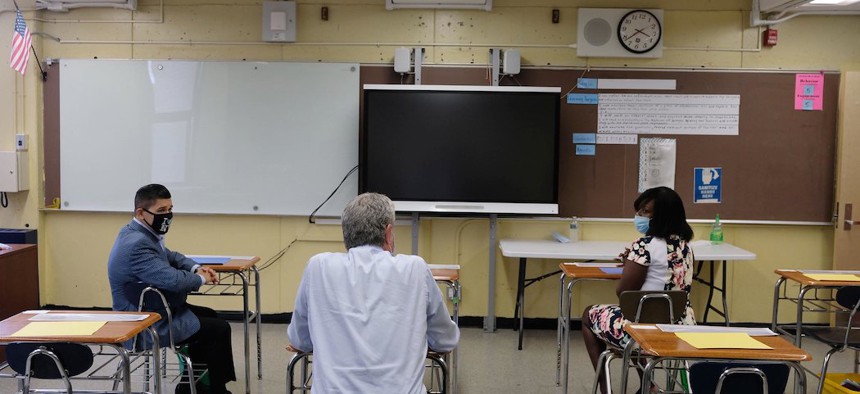On Monday, New York City Mayor Bill de Blasio said schools could make use of outdoor spaces for class. “The disease doesn’t spread the same outdoors. We’ve seen that over and over. So we want to give schools the option to do as much outdoors as they can,” he said during a press conference.
Schools may teach students in schoolyards, and principals can request permission from the city to hold classes in streets and local public parks. The schools would also be required to provide their own barriers to block off space in the streets. Schools from the 27 neighborhoods that were hit the hardest by the coronavirus pandemic, as well as those that do not have schoolyards, will be given first priority for street and park space.
All principals interested in outdoor learning have also been asked to submit their plans for outdoor teaching by Friday. However, the city itself has not provided a plan, or much guidance, as to what this might look like. The city has also failed to address how schools should deal with the costs associated with moving lessons outside, what liabilities they may face or what to do if there’s inclement weather. City schools are still scheduled to reopen on Sept. 10, despite calls from principals and teachers unions to delay reopening over safety concerns.
While the Council of School Supervisors and Administrators, which represents 6,400 school leaders, supports outdoor learning, the organization has said de Blasio has given their members little time to prepare schools to teach outside. “The shortsighted guidance on outdoor learning also lacks detail, raising serious concerns around safety and security. Furthermore, without funding, this plan will exacerbate already existing disparities,” President Mark Cannizzaro said in a statement. “The City’s plan will not be implemented nearly as well as it could have been if the Mayor had simply given principals the time and support they need.”
The United Federation of Teachers similarly stated that de Blasio’s reopening plan “continues to fall short, particularly in terms of necessary testing.”
The city’s parents and educators have been asking the city to consider allowing schools to teach in the streets and parks as an alternative to cramming into classrooms, where the virus is more likely to be spread, but city officials have been reluctant to listen until now – two weeks before the start of the school year.
The World Health Organization recommended that schools try to take lessons outdoors as much as possible, as did the American Academy of Pediatrics. Italy is currently looking to conduct classes outdoors in amphitheaters, stadiums, parks and open-air museums because of the coronavirus. And schools in Florida and North Carolina have already begun to adopt outdoor schooling.
Rice University in Houston has already purchased large circus tents for outdoor classes and student activities this fall. Public schools could also purchase tents for classes but the cost could be a big impediment. City school officials have not indicated whether or not additional funds would be allocated to purchase items that would make outdoor classes more feasible. However, schools Chancellor Richard Carranza suggested that parent associations could raise money for supplies. “I’m asking that if a PTA has done their fundraising and they’ve raised more than enough for their school, let’s identify another school that doesn’t have that fundraising capacity – let’s help them out too,” Carranza said.
Private schools around the state have begun preparing for outdoor learning with tents to protect students against the sun and inclement weather, mandatory coronavirus tests before students return to school and maintaining lots of space between students. Unlike most city public schools, most of the state’s private schools tend to have smaller class sizes and large campuses, which allow them to set up tents and space out students.
In 1907, two doctors created a plan for an open-air school in Rhode Island to see if it could reduce the transmission of tuberculosis among children, inspired by schools in Europe that taught outside. Children stayed warm in their classes during the icy winter while wrapped in heated blankets and none of them fell ill. Two years later schools across the country, including a few in New York City, adopted this model of outdoor teaching. During the 1918 Spanish flu pandemic, however, city schools remained open because they were considered a means of disease prevention, since most schoolchildren lived in tenements that were often crowded and unhygienic. While teaching outside may have fallen out of favor in the U.S., many European countries have continued to utilize the great outdoors. In Scandinavia, classes are often taught outside during the spring and summer.
Despite the issues associated with setting up outdoor learning, there are positive benefits attributed to holding classes outside that don’t have to do with disease prevention. Several studies have shown that students can focus better and they do better in class when they’re taught outside.
NEXT STORY: Should cops carry guns?


